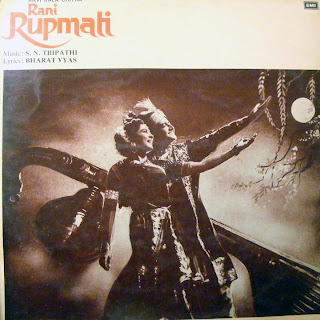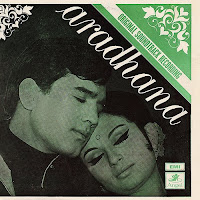Book 2: Bollywood: A History (2006)
Written by Mihir Bose in 2006, with lots and lots of help (a whole chapter is dedicated to the people inside bollywood).
Bollywood: A History focuses on different subjects such as the beginning of the Indian film industry, the film studios, he lightly touches films like
Mughal-e Azam and
Mother India and he also writes about the change after independence and so on.

Mihir Bose is a writer who specialises in sport. He is not a film scholar, but he is a good writer. His style is light and flowing, so no one should have a problem reading this book. It is much less school oriented then
Indian Film (published by oxford university press,
read post) this one is more open to the general public. For more information on Mihir Bose, just visit his
web site.
Oh, god, don't get me started on the UK cover. Hmm...is that almost naked and wet Rekha?! Come on, I want a book that sells for it's content, not it's cover. But one thing I did realise is that Bollywood, through history, has objectified women, and in that sense the cover fits just "nicely" with what it's talking about. But, I still prefer the to dry and breast covered Rekha.


Pictures -
Uk Edition (Tempus) and
India edition (Roli Books)
One other thing that bugs me is the title and the content don't match 100%. Especially if the title is
Bollywood: A History (the history part, is not just history). History is present in the book, but in, what I felt, was a tainted form. You couldn't help but doubt the accuracy of some things that were written because it felt more like information in the "He said, She said" category. An example of this is the speculation of the Lata Mangeshkar and C. Ramchandra romance. Lata does not mention it in her biography and C. Ramchandra is dead, while there is no actual proof, you can call this information a rumor or a hidden secret, but not history. Most of the facts are taken from other peoples work or written in quotes from people in the industry.
Anyway, gossip and rumors themselves have there place in the book. Like in the prologue, which is read more as a long magazine article (though at the end it gets more serious), is about Bose's interview of the then rising start Madhuri Dixit and how he made her cry in in front of Sunil Dutt because he asked her "So, how do you feel about being the new sex symbol of Bollywood?" He also writes about Pamela Bordes, a once Miss India turned high class escort that created much scandal and excitement at the time.
The most interesting chapter, for me, was "
The Road to Bombay via Munich and London" is about the pre-studio and studio days of the educated Devika Rani and her husband Himanshu Rai. I love that Rani worked with German directors Fritz Lang and G. W. Pabst, (wow, sooo jealous!)
Anyway, what I think would have made the book better is if the titles would represent the content. Basically the problem is Bose claims to write about many events and personalities in each chapter but actually he focuses on one.
some examples are:
"The Road to Bombay via Munich and London" - Devika Rani and Bombay Talkies
"Blondes and Brunettes: Bollywood's White Woman" - Fearless Nadia
"The Explosion of the Bombay Film Song" - Lata Mangheshkar
You end up expecting a lot more then what you get.
Also the title
Bollywood A History should be changed to "People who Shaped Hindi Cinema" or something like that. At least it wouldn't be false (and the book would have probably gotten a better rating from me).
UpsideReally fun and easy to read.
More explanation was written for beginners in this area if world cinema.
Downside The author is not an expert of cinema.
The UK cover can't make me take his book seriously.
Gossip and personal experiences instead of history.
I felt that the chapters or at least there titles where not representative of what you where about to read. For example, one chapter on Bombay Film Music was mainly on Lata Mangeshkar, so if you were looking for information, let's say on R. D. Burman, you get like five lines.
Other reviews
Here is an another review of
Bollywood: A History, written by Chandrahas Choudhury, on his blog
The middle Stage, who I think has a similar opinion to mine.
And,
here (you will need to scroll down), a review by journalist Jai Arjun Singh on his blog
Jabberwock.Stella's score:
2.5/5 (for people who actually know about the history of Bollywood)
3.5/5 (for beginners)
 Basically, Sahib Bibi aur Ghulam is a classic Indian film, based on the book by Bimal Mitra. It was India's entry for the Oscars in 1963 and stars Meena Kumari (in one of her most famous roles) as a drunken rich house wife in the province of Bengal during the end of the 1800's.
Basically, Sahib Bibi aur Ghulam is a classic Indian film, based on the book by Bimal Mitra. It was India's entry for the Oscars in 1963 and stars Meena Kumari (in one of her most famous roles) as a drunken rich house wife in the province of Bengal during the end of the 1800's. Initially, I got this album for two songs. The first, and my favorite, "Piya Aiso Jiya Men" is simply a classic Geeta Dutt song that I love. The second is "Sakhiya Aaj Mujhe Neend Nahi Aayegi", beautifully sung by Asha Bhosle and wonderfully picturised by Guru Dutt on the lovely Meenu Mumtaz (Minoo Mumtaz).
Initially, I got this album for two songs. The first, and my favorite, "Piya Aiso Jiya Men" is simply a classic Geeta Dutt song that I love. The second is "Sakhiya Aaj Mujhe Neend Nahi Aayegi", beautifully sung by Asha Bhosle and wonderfully picturised by Guru Dutt on the lovely Meenu Mumtaz (Minoo Mumtaz).
 Waheeda Rehman. But every song on the album has its own charm and I am sure everyone would like one, at the least.
Waheeda Rehman. But every song on the album has its own charm and I am sure everyone would like one, at the least. John Abraham(I posted the poster just below.) I don't know? a classic is a classic, I wouldn't have remade it, especially with poptart actors, well it's their chance to prove that they can act, and I hope they succeed.
John Abraham(I posted the poster just below.) I don't know? a classic is a classic, I wouldn't have remade it, especially with poptart actors, well it's their chance to prove that they can act, and I hope they succeed.











 The Eyes: Lots of black eyeliner and pale eye shadow.
The Eyes: Lots of black eyeliner and pale eye shadow.

 This is a great soundtrack and, in my opinion, one of Laximikant and Pyarelal's best.
This is a great soundtrack and, in my opinion, one of Laximikant and Pyarelal's best. .JPG)



.JPG)




 Mihir Bose is a writer who specialises in sport. He is not a film scholar, but he is a good writer. His style is light and flowing, so no one should have a problem reading this book. It is much less school oriented then Indian Film (published by oxford university press,
Mihir Bose is a writer who specialises in sport. He is not a film scholar, but he is a good writer. His style is light and flowing, so no one should have a problem reading this book. It is much less school oriented then Indian Film (published by oxford university press, 


 800 x 600
800 x 600 Widescreen
Widescreen















